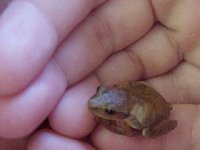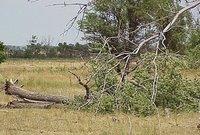Each March, nature centers and Audubon groups sponsor “woodcock walks,” as much a part of the tradition of spring as spotting robins in the yard or Red-wing Blackbirds in the swamps.
The American Woodcock is famous for its mating maneuvers. In his Essential Field Guide Companion, Peter Dunne describes it concisely: “Aerial courtship display is arresting and easily observed at dawn and dusk. Birds spiral aloft, calling as they climb, then descend rapidly to earth like broken kites. After an interval, the display is repeated.”
 |
| Late snow can be deadly for 'timberdoodles' |
What also makes woodcock fascinating is that they are actually shorebirds – members of the Sandpiper family – that eons ago moved inland and inhabit forests and fields instead of beaches and dunes. Their main food is earthworms.
It is a pudgy bird whose neckless head appears to be what Dunne calls “a bump on the body.” He says that the overall effect of the bird is like viewing a “meatloaf on a stick.”
They have endeared themselves to countless generations of farmers and nature-lovers, who often call them “timberdoodles.”
The American Woodcock has been somewhat in decline in Connecticut, probably because of habitat loss. But in March, late winter storms can also take their toll. In 2007, there was a big St. Patrick’s Day storm, and many reports of dying woodcock.
For instance, George Rieger of Greenwich told us, “The morning after the recent ice/snow storm we found a woodcock outside of our front door near Bruce Park in Greenwich. The bird appeared healthy but was weak and unable to fly.
“We put it in a box with torn up newspaper and some water. We tried to keep the bird warm but not too warm. After 24 hours the bird was strong enough to escape the box and flutter about.”
He took them to a nearby sanctuary.
“Three birders were at the sanctuary. They suggested that we let the bird try to make it. I was skeptical. Two of the men took the bird to a tree and released it. I said to my wife and the third man that the woodcock was bait for predators.
“No sooner had I spoken than I saw a black shape flying toward the woodcock. I yelled ‘crow.’ The youngest of the two men sprinted toward the woodcock and arrived just in time to dislodge it from the crow's beak.
“We left the beautiful woodcock with the birders whom I am certain did the best that they could for the bird.”
They may have taken it to Meredith Sampson, director of Wild Winds Inc., and a wildlife rehabilitator in Old Greenwich. She had gotten many woodcocks that season.
Meredith reported on the Connecticut Birds internet discussion group, “Received the eighth woodcock for rehab. Sad to report the bird expired about a half hour later. It was extremely emaciated at 101 grams and apparently crashed into something which resulted in a misaligned beak and severe eye injury. Found in downtown Stamford.
“Out of the eight woodcocks in rehab, two have survived and were released three evenings ago. All came in severely emaciated, weights averaging around 90-100 grams.
“It's rare that I get in this species – I don't even get one a year! It’s heartbreaking to see this happening.”
What was happening? Milan Bull of Connecticut Audubon offered an answer on Connecticut Birds.
“Woodcock are apparently dying in considerable numbers across the Northeast this spring due to a crusted snow pack isolating these early migrants from the soil and earthworms below. We have had calls throughout Connecticut from members and wildlife rehabilitators reporting dead and emaciated woodcock in numbers I haven't seen in similar past events, and those are only the ones that are discovered!
“This is not a good sign, considering woodcock are on a long-term decline as it is.”
Fortunately, soon after, warm weather arrived and melted the hard-topped snow, giving the surviving woodcock access to their worms.
And fortunately, our hard and thick pack this year has been steadily melting and in many places, has disappeared.
 To peepers, a sudden freeze or even a spring snowstorm is no sweat. Cold air triggers the frog's liver to create glucose. Blood brings this antifreeze to the vital organs like the brain and heart, keeping them from freezing. But the rest of its body — more than 60% of it — can freeze for weeks without harming the frog.
To peepers, a sudden freeze or even a spring snowstorm is no sweat. Cold air triggers the frog's liver to create glucose. Blood brings this antifreeze to the vital organs like the brain and heart, keeping them from freezing. But the rest of its body — more than 60% of it — can freeze for weeks without harming the frog.



.jpg)












